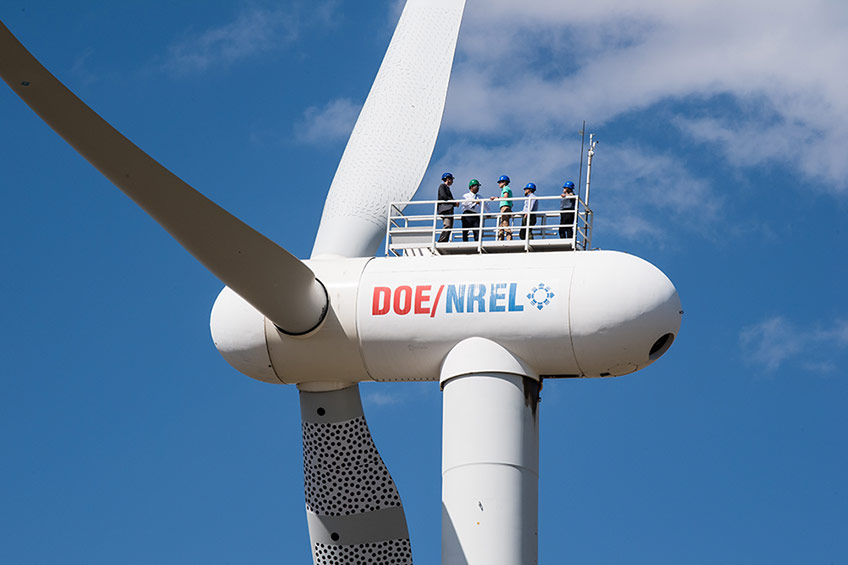Webinar Series Inspires Tomorrow’s Wind Energy Innovators

NREL is engaging tomorrow’s wind energy innovators today with our Wind Workforce Development Webinar Series. Photo by Dennis Schroeder, NREL
The wind workforce of tomorrow is recruited with today’s inspiration, and the National Renewable Energy Laboratory (NREL) is generating the spark.
The Wind Workforce Development Webinar Series places students and educators in the virtual room with today’s foremost experts in wind energy technologies.
“Wind energy is an industry that is rife with innovation," said Ram Poudel, NREL engineer and coordinator of the webinar series. "Our goal is to bring the research leaders from across laboratories, universities, and industry into lecture halls across the country.”
What better way to inspire tomorrow’s wind energy professionals than to introduce them to trailblazing wind work today?
In fact, just around the corner, on May 19, NREL Grid Systems Principal Energy Analyst Paul Denholm will lead our next webinar: “Grid Services from the Modern Wind Turbines: Engineering and Economics.” For information on how to attend this meeting, please email Ram.Poudel@nrel.gov.
Wind Energy Experts on Demand
The Wind Workforce Training and Education efforts, implemented by NREL for the U.S. Department of Energy (DOE) Wind Energy Technologies Office, is encouraging tomorrow’s wind energy pioneers by introducing students and educators to wind energy through educational opportunities across a range of academic levels.
Led by state university or college professors, DOE supported Wind Application Centers (WACs) provide undergraduate and graduate students with tailored wind curricula and a hands-on experience in wind energy technologies.
The Wind Workforce Development Webinar Series is targeted to these centers, as well as universities offering wind or renewable energy courses.
North Carolina’s Appalachian State University is home to a WAC, and the AppState students in the Sustainable Technology program, both undergraduate and graduate, have benefitted from this series.
“This timely, technical information has exposed our students to high-level research activities, inspiring them to continue to challenge themselves in their own research activities and class work,” said Brent Summerville, practitioner-in-residence in sustainable technology at Appalachian State University.
“The webinars on Nacelle Mounted LiDAR and Wind-Hydro Integration were both very appropriate for my Wind & Hydro Power Technologies students,” he said.
Through the WACs, NREL and DOE collect webinar topic requests, accommodating several suggestions each year.
NREL then pinpoints researchers that are best matched to that webinar topic, essentially offering webinars “on demand.” The webinars can then be incorporated into coursework to help ensure that students coming out of U.S. academic institutions are at the forefront of industry learning, a key need identified in the recently published NREL report, “The Wind Energy Workforce in the United States: Training, Hiring, and Future Needs.”
“Some look at wind and hydropower as old technologies—that as a research topic, it’s a done deal,” said Poudel. “We need to change this view.”
Highlighted in a recent Science article, “Grand Challenges in the Science of Wind Energy,” the need for additional research in the wind energy field is of paramount importance for the industry.
“We want undergraduate and graduate students to come and see all the cool research going on at NREL and across the wind industry," he said. "They’ll see this in their class, and we’ll get more people interested in the field."
The Wind Workforce Development Webinar Series aims to not only educate, but to bring these would-be wind superstars into the fold.
Developer-Led Software Demo
Since its January 2019 inception at the Wind for Schools Summit held at NREL’s Flatirons Campus, the series has presented three hour-long webinars.
In December, the series welcomed engineer and software developer Liz Walls to the mic.
Walls is the creator and developer of the Continuum wind flow modeling software. Development of the groundbreaking software began in 2011, and by October 2019 Continuum 3 was released as an open-source resource on GitHub.
With Continuum, her goal was to create an intuitive, user-friendly software that quickly develops accurate wind energy estimates.
During her webinar, “Wind Flow Modeling over a Complex Terrain using Continuum 3.0,” Walls presented various wind flow models, including the Continuum model.
She provided a demo of the software to guide participants in creating a wind flow model, generating turbine estimates, and producing wind speed maps.
Lidar Wind Industry Applications
In January, Eric Simley, a control systems research engineer, and Andrew Scholbrock, a mechanical engineer, both at the National Wind Technology Center at NREL, presented a webinar titled, “Nacelle Mounted LiDAR for Wind Energy Applications.”
Simley and Scholbrock serve on the advisory board of International Energy Agency Wind Task 32, which focuses on lidar for wind energy applications.
They described the two types of lidar—range finding and Doppler—and then explained nacelle-based lidar applications for the wind industry.
Simley and Scholbrock spelled out how this technology can improve yaw alignment of wind turbines and annual energy production, as well as how it can be used to anticipate wind disturbance and reduce turbine loads.
They also presented the case for lidar-improved power performance measurements and their research applications.
Enabling Renewable Integration
In March, Thomas Acker, Northern Arizona University professor of mechanical engineering, and Greg Stark, NREL hydropower technical manager and water power grid integration lead, presented “Integrated Energy System at Scale: Wind and Hydro Integration.” In their webinar, these experts discussed how hydropower and wind can hasten wind energy expansion on the grid.
The event touched upon the current state of hydropower and wind energy in the United States, electrical system supply and demand, and how wind and hydro are positioned to meet these demands.
The webinar delved into the complicated, but important, relationships between wind, transmission, and pumped-storage hydropower.
Coming Soon
The webinar series returns in mid-May with “Grid Services from the Modern Wind Turbines: Engineering and Economics.” To attend this meeting, please email Ram.Poudel@nrel.gov.
The presentation will zero in on how, as variable renewable energy sources such as wind and solar expand on the grid, they can provide stability and other grid services.
Learn more about NREL’s wind research and DOE’s Wind Energy Technologies Office.

